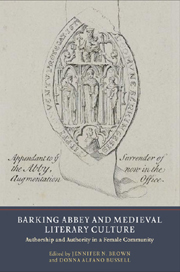Book contents
- Frontmatter
- Contents
- List of Contributors
- Acknowledgements
- List of Abbreviations
- Dedication
- Introduction: Barking's Lives, the Abbey and its Abbesses
- I BARKING ABBEY AND ITS ANGLO-SAXON CONTEXT
- II BARKING ABBEY AND ITS ANGLO-NORMAN CONTEXT
- 5 ‘Sun num n'i vult dire a ore’: Identity Matters at Barking Abbey
- 6 ‘Ce qu'ens li trovat, eut en sei’: On the Equal Chastity of Queen Edith and King Edward in the Nun of Barking's La Vie d'Edouard le confesseur
- 7 Body, Gender and Nation in the Lives of Edward the Confessor
- 8 Clemence and Catherine: The Life of St Catherine in its Norman and Anglo-Norman Context
- 9 Cicero, Aelred and Guernes: The Politics of Love in Clemence of Barking's Catherine
- 10 The Authority of Diversity: Communal Patronage in Le Gracial
- III BARKING ABBEY AND THE LATER MIDDLE AGES
- Afterword. Barking and the Historiography of Female Community
- Bibliography
- Index
- YORK MEDIEVAL PRESS: PUBLICATIONS
6 - ‘Ce qu'ens li trovat, eut en sei’: On the Equal Chastity of Queen Edith and King Edward in the Nun of Barking's La Vie d'Edouard le confesseur
from II - BARKING ABBEY AND ITS ANGLO-NORMAN CONTEXT
Published online by Cambridge University Press: 05 April 2013
- Frontmatter
- Contents
- List of Contributors
- Acknowledgements
- List of Abbreviations
- Dedication
- Introduction: Barking's Lives, the Abbey and its Abbesses
- I BARKING ABBEY AND ITS ANGLO-SAXON CONTEXT
- II BARKING ABBEY AND ITS ANGLO-NORMAN CONTEXT
- 5 ‘Sun num n'i vult dire a ore’: Identity Matters at Barking Abbey
- 6 ‘Ce qu'ens li trovat, eut en sei’: On the Equal Chastity of Queen Edith and King Edward in the Nun of Barking's La Vie d'Edouard le confesseur
- 7 Body, Gender and Nation in the Lives of Edward the Confessor
- 8 Clemence and Catherine: The Life of St Catherine in its Norman and Anglo-Norman Context
- 9 Cicero, Aelred and Guernes: The Politics of Love in Clemence of Barking's Catherine
- 10 The Authority of Diversity: Communal Patronage in Le Gracial
- III BARKING ABBEY AND THE LATER MIDDLE AGES
- Afterword. Barking and the Historiography of Female Community
- Bibliography
- Index
- YORK MEDIEVAL PRESS: PUBLICATIONS
Summary
The nun of Barking who composed La Vie d'Edouard le confesseur was at once the beneficiary of a rich Anglo-Saxon literary past and an innovator uniquely equipped to contribute to twelfth-century England's rich store of creative works in French. When she set out to write the life of King Edward the Confessor, he had already been the subject of three Latin lives: hers would be the first Edward life in the French vernacular. The first of the Latin lives, commissioned by Edward's wife, Queen Edith, was the Vita Aedwardi regis qui apud Westmonasterium requiescit (‘The Life of Edward who Rests at Westminster’), composed between 1065 and 1067. The second, Osbert of Clare's Vita beati Eadwardi regis Anglorum (‘The Life of St Edward King of England’), based on the earlier work, was written in 1138 in the hope of seeing Edward sanctified; had the attempt not failed, Osbert's abbey of Westminster, once rebuilt by Edward, would have benefited. Osbert's work then became the source of Aelred of Rievaulx's new Vita sancti Edwardi regis et confessoris (‘The Life of St Edward King and Confessor’), which appeared in 1163 to celebrate Edward's translation to Westminster and his canonization two years earlier through King Henry II's efforts. In its turn, Aelred's work, ‘a piece of distinctly Angevin propaganda written for Henry II’, became the principal source for the French poem.
- Type
- Chapter
- Information
- Barking Abbey and Medieval Literary CultureAuthorship and Authority in a Female Community, pp. 135 - 144Publisher: Boydell & BrewerPrint publication year: 2012

